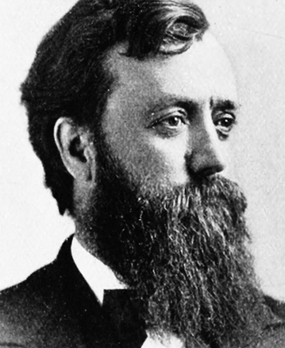Newton Horace Winchell:
How he has transformed the scene
Discovering Minnesota's Riches and Resources
The year was 1872. Ulysses S. Grant was president of the United States, Minnesota had been a state for just 14 years, and Newton Horace Winchell came to Minnesota as the first-ever State Geologist. He was charged with directing "The Geological and Natural History Survey of Minnesota," a comprehensive dossier of the state's abundant natural resources.
Legislators at the Capitol wanted to better understand the plentiful resources — everything from water to iron ore — that could benefit the growing state. They handed over administration of the survey to the University of Minnesota, which although established in 1851, had been in actual operation for only three years at the time.
And so Winchell (who was also teaching geology, botany and zoology at the University) and his associates set out county by county, over 80,000 square miles of terrain, to meticulously catalog every aspect of plant, animal and natural feature in Minnesota. They painstakingly recorded each rock, stone and mineral formation, as well as all types of soils and sub-soils. They carefully mapped topographical features, such as the elevation of lakes and hills, and even tested the water quality in lakes and rivers. They listed all species of mammals, birds, plants — even fossil formations of mollusks, invertebrates and plants — found throughout the state.
4,130 Pages That Helped Minnesota Prosper
Winchell's nearly three decades of work resulted in the six-volume publication The Geology of Minnesota: Final Report of the Geological and Natural Survey of Minnesota, which was comprised of 4,130 pages, 261 full-page illustrations (known as plates), 420 figures, and an atlas.
The report was one of the most complete and carefully detailed projects of its kind in American scientific history. Its findings were not only of great scientific importance, they also helped the state begin to understand and use its natural resources to build a successful and prosperous economy. As George M. Schwartz from the University of Minnesota's Newton Horace Winchell School of Earth Sciences wrote, "Any attempt to do justice to the work of … Winchell within a reasonable space is frustrated by the immensity of his accomplishment."
When Exactly Did St. Anthony Fall?
In 1680, St. Anthony Falls — the only true waterfall on the Mississippi — became known to the Western world when Catholic friar Father Louis Hennepin's described them in his published journal. Another 200 years would pass before another momentous finding was made about the falls, this time thanks to Winchell.
By determining the rate of St. Anthony Falls' recession, and by taking the unusual step to relate its retreat to the Ice Age, Winchell was able to accurately estimate the duration of time since the Ice Age — long before the modern method of radiocarbon dating. Winchell determined that about 10,000 years had passed since the Ice Age, a discovery which astounded his peers around the world and greatly advanced scientific thinking and methodologies across the entire field of geology.
A Museum & A Hiking Trail: Experience Winchell's Lasting Imprint Today
Winchell's contributions to the scientific community of his time made a significant, lasting imprint. So, it's fitting that today, any Minnesotan can easily encounter Winchell's influence. For example, a visit to today's Bell Museum of Natural History would not be possible without Winchell. What we now know as the Bell started as just a mere mention in the original plans for the Geological and Natural History Survey. It was Winchell who brought those plans to fruition, and was the museum's first director from 1872-1889.
Observant hikers near the Franklin Avenue Bridge in Minneapolis may notice a large boulder from the Mesabi Iron Range marking the start of the Winchell Trail. The boulder has a plaque with an inscription that aptly honors and memorializes Winchell's lasting contributions to Minnesota:
The Winchell Trail Marked by this boulder brought from the Mesabi Iron Range, was named in honor of the eminent geologist Newton Horace Winchell whose scientific studies along this river provided a measure for the time since the glacial period. His early appreciation of the economic importance of Minnesota's resources did much to preserve for the people some share in the state's mineral wealth.
Winchell remained state geologist until 1900. He then oversaw the Minnesota Historical Society's department of archeology until his death in May 1914.

